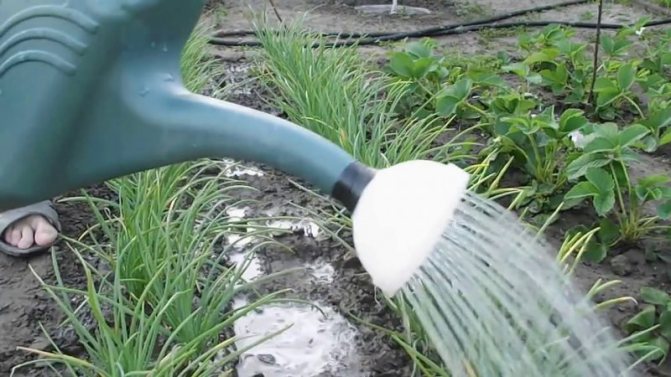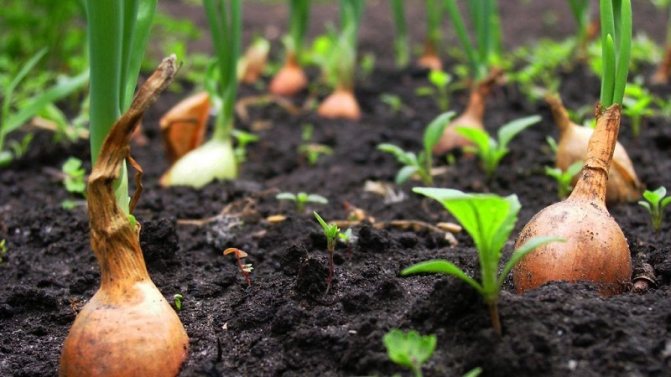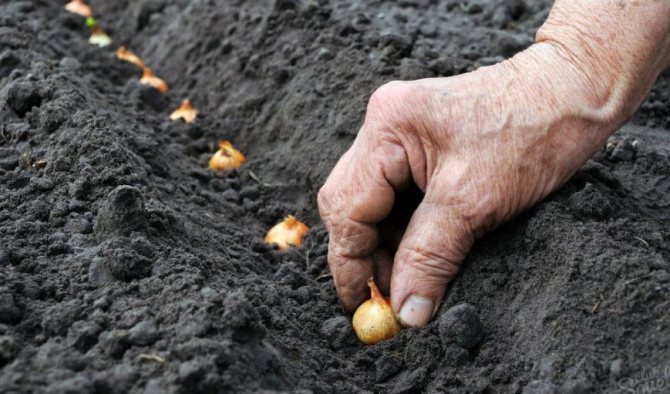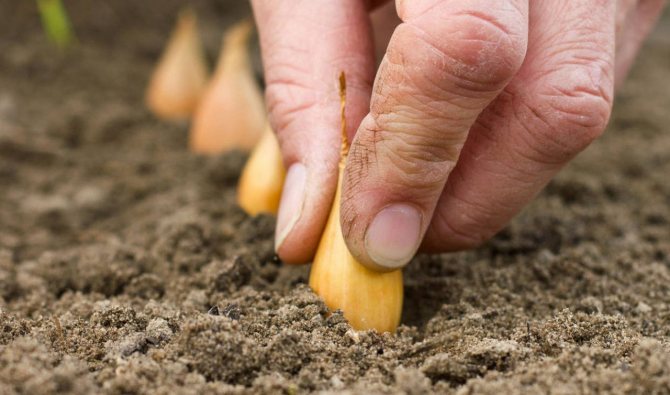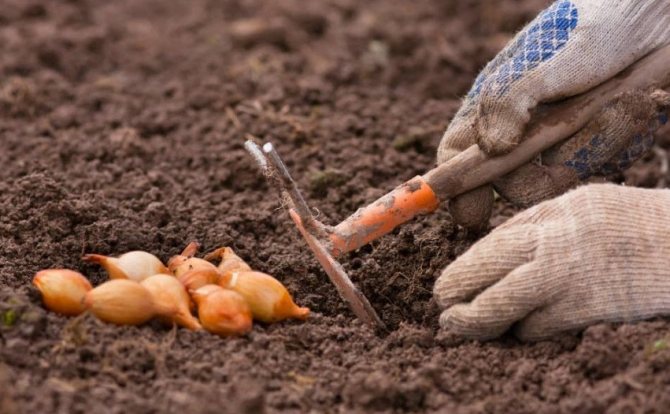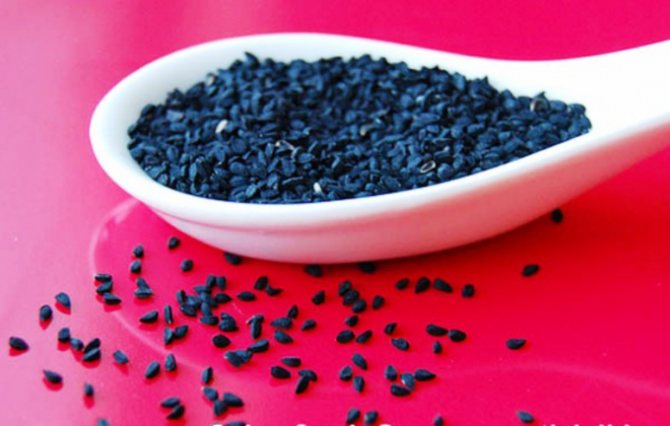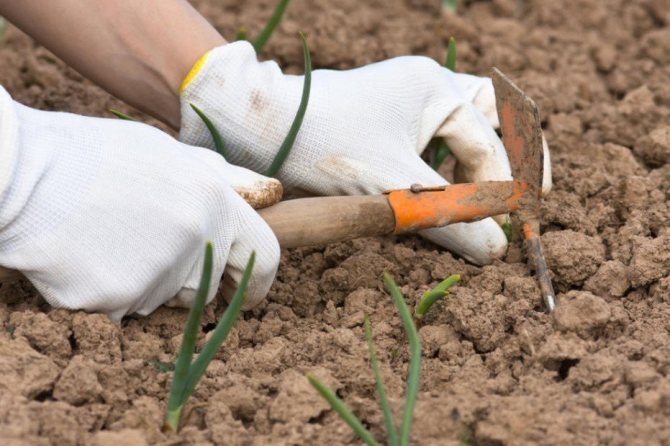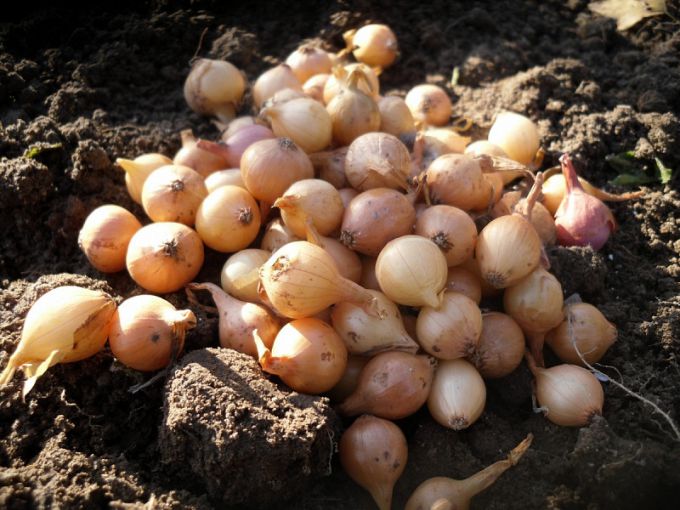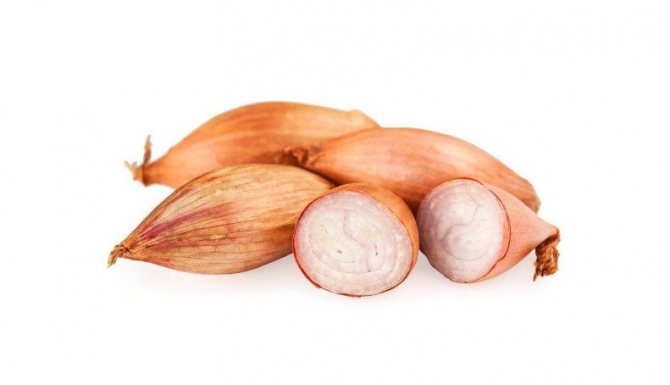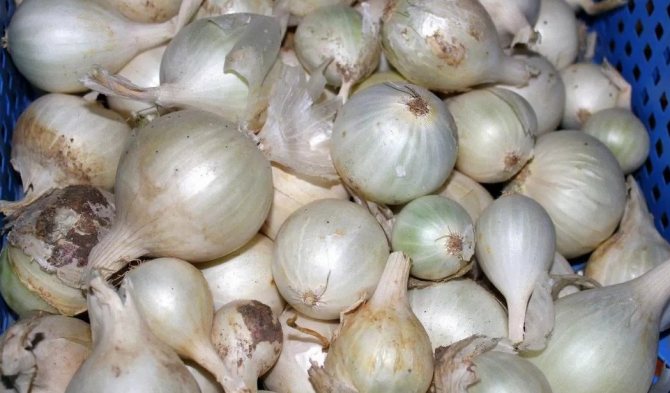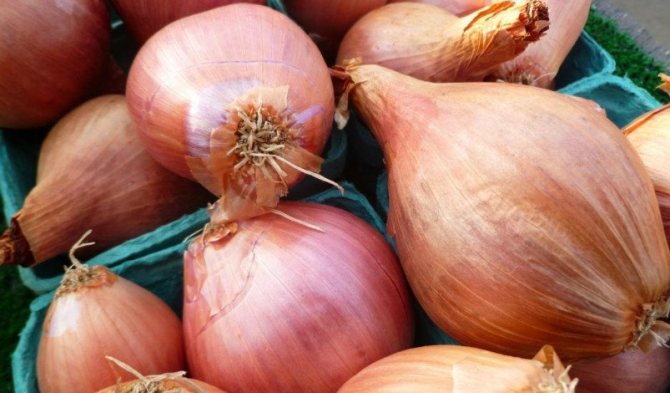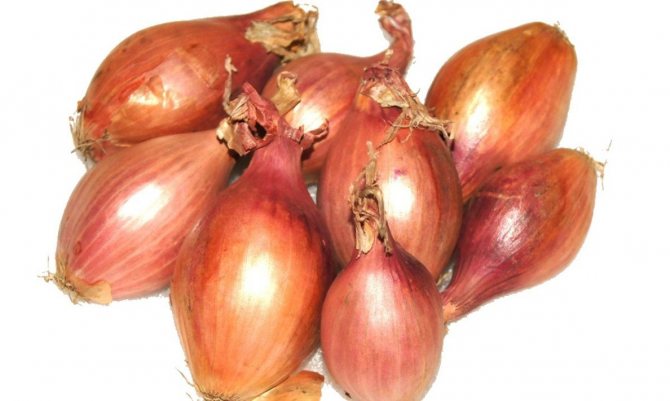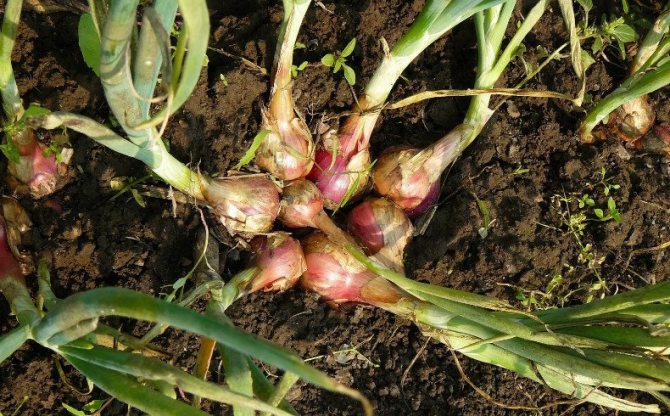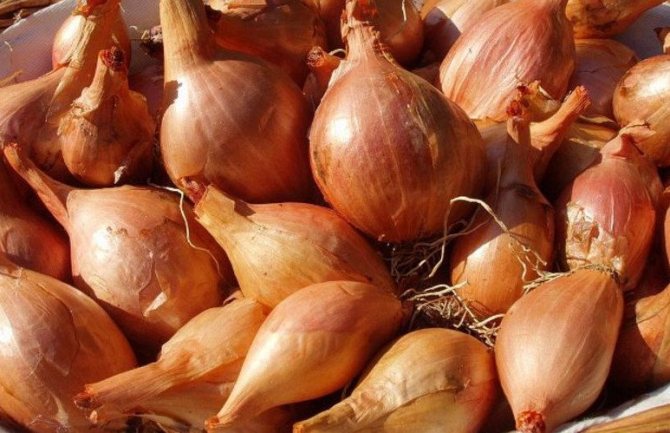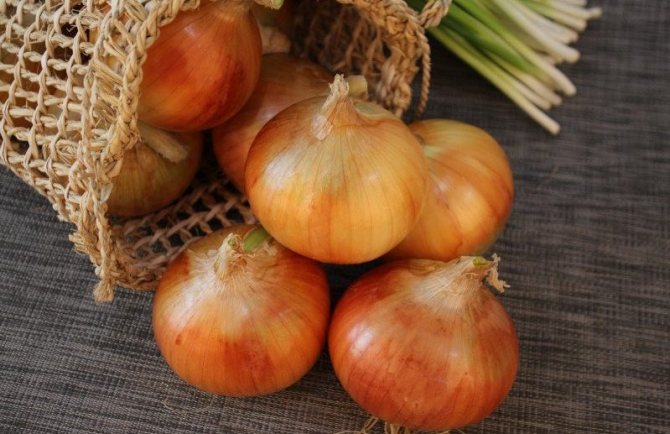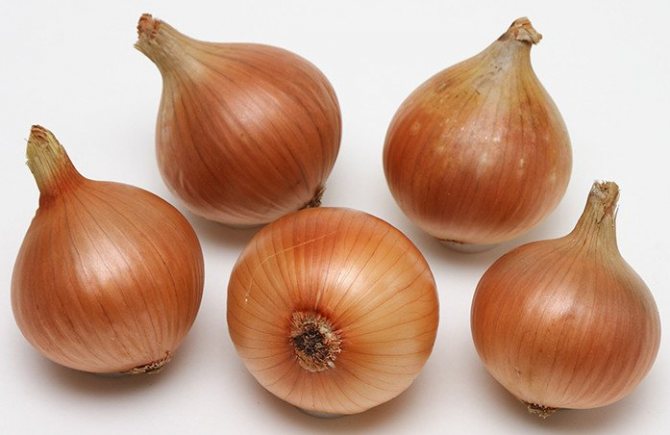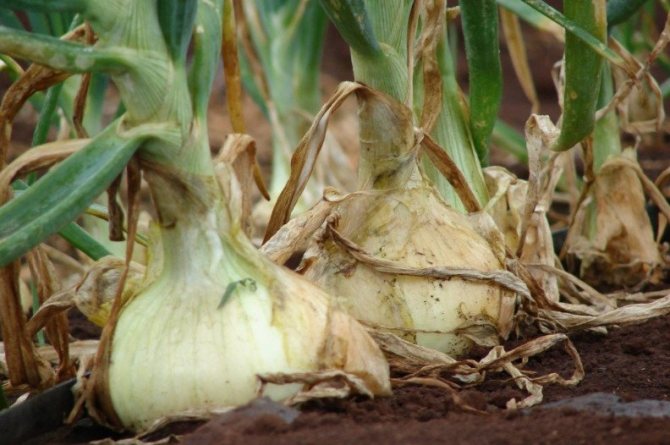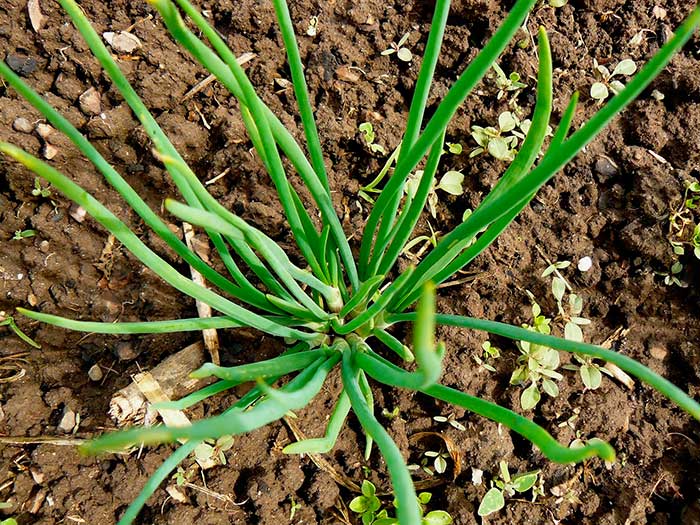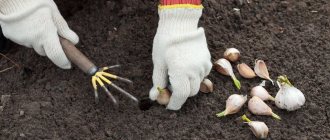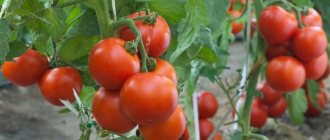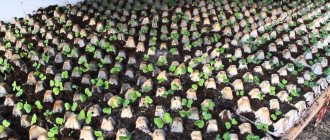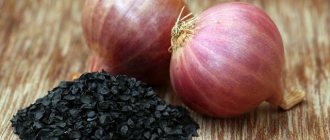The selection of family onions (shallots) began in the northern regions of Russia. Since ancient times, vegetables have been cultivated in the Vologda gardens, helping to survive in the harsh conditions of the northern taiga. Cabbage, family onions and turnips saved from scurvy and disease. Modern breeders study shallots and develop their remarkable qualities: exceptional early maturity and long-term storage capacity. Shallots ripen 65-70 days after planting. The onion is stored for up to 12 months, while it does not lose its qualities at all. The bulbs are multi-primordial, therefore, by planting one bulb in the spring, at the end of summer you can get up to a dozen commercial bulbs. And also the indisputable advantage of the family onion is winter hardiness, it can be planted both before winter and during the February thaw, it takes root well. The people call him Sorokozubka, Kushchevka, Semeyka. We offer you to get acquainted with the best varieties of shallots of domestic selection.
Landing
In autumn, family onions are planted 40-50 days before the arrival of persistent night frosts. It is important that the bulbs have time to fully expand the root system by winter.
For planting, both seeds with a suitable expiration date and a small set with a bulb diameter of 1 to 2 cm are suitable. Whatever planting material you choose, it must be healthy.
I advise you to choose only proven varieties and hybrids that are not prone to shooting - "Garant", "Debut", "Krepysh", "Earring", "Sprint".
The family should be planted in areas well-lit by the sun without stagnant moisture in late August - early September.
Approximately 25-30 days before the expected date of planting, the soil is dug up, simultaneously introducing fertilizers into it at the rate of 70 g of double superphosphate and 5.5 kg of humus per 1 m2. Additionally, I recommend adding wood ash.
It is important to keep the soil moisture high in the fall. If there is little rain, do artificial watering before the night frost arrives. Water during this period will contribute to the accelerated growth of the root system.
Growing from seed
Before planting, the selected healthy bulbs are treated first with a pink solution of potassium permanganate, then with a growth stimulant. As a result, the surface will be disinfected, after planting, the root system will begin to develop faster.
Some summer residents prefer to disinfect the sevok by heating it to +40 C for 8 hours.
The bulbs are planted in small rows 30 cm apart. The optimum planting depth is about 3-4 cm. Neighboring bulbs in a row should be planted in increments of about 25 cm, since each of them will subsequently form a large nest.
Planting must be mulched with humus or straw. In the Urals and Siberia, when snow falls, it must be thrown over the mulch, forming snow caps. In the spring, with the arrival of heat, the mulch is removed so that the ground that was under it begins to warm up faster.
Planting before winter using sevka
- Planted in late September-early November;
- Before planting, it is warmed up for 8 hours at a temperature of 40 degrees to prevent further development of diseases;
- They are planted in rows at a distance of 10-15 cm to a depth of 3-4 cm. The distance between the bulbs should be 25-30 cm;
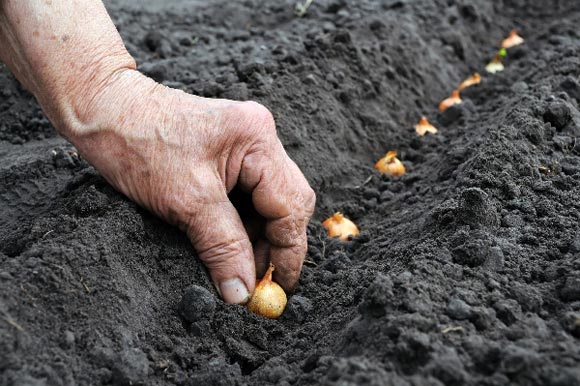
- The earth is compacted and covered with mulch from sawdust, straw, humus, etc.;
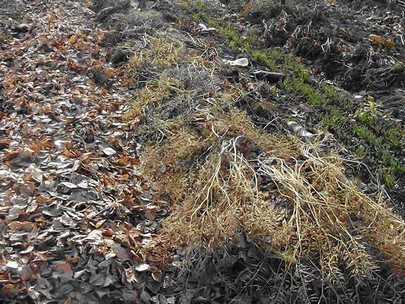

- When snow falls, it needs to be thrown over the garden to keep warm.
- In the spring, when warmth comes, the mulch should be removed;
- Watering should be rare when dry;
- Onions should be weeded when weeds appear;
- Loosening should be careful so as not to damage the roots;
- If the onion is grown to obtain a turnip, then it is not recommended to pinch off the feather;
- If the feather turns yellow and lodges, the onion can be harvested;
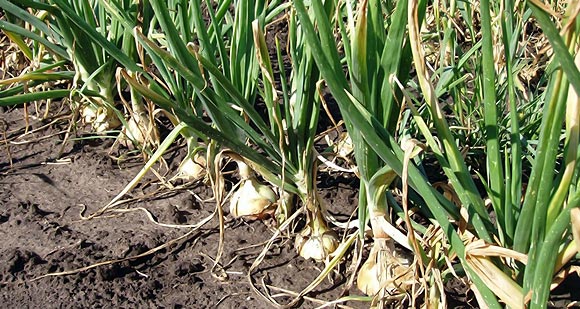

- 8-10 days before collection, watering must be stopped;
- The collected onions can be collected in braids or cut off the feather at a distance of 3-4 cm from the bulb;
- Store in a dry place.
Thus, family onions, despite the modest size of the bulbs themselves, will delight you with an early and rich harvest.
Growing from seeds
Before planting, shallot seeds are soaked in solutions of growth stimulants. They are planted, like sevok, in rows. They are placed at a distance of about 25 cm from each other. The depth of planting seeds in the soil is from 1 to 1.5 cm.It is convenient to make long grooves into which it is necessary to plant seeds in increments of 16-18 cm.
Don't plant seeds more often. With a thicker planting, the quality and abundance of the crop will be seriously affected.
At the end of the event, the soil is compacted and mulched.
With the right approach, from 1 m2 you can get up to 10 kg of family onions.
Description and characteristics of the family bow
A vegetable crop such as onion has several varieties. Among them is a group of multi-primordial varieties with a large number of onions in the nest. Their number depends on the variety; on average, from 4 to 10 pieces are formed (but there can be much more). It is in this category that the family onion belongs, which has long been grown in the northern, north-western and central regions of Russia.
How family onions differ from other varieties:
- Several bulbs are formed in one nest, each weighing about 30-50 grams. When carrying out special agricultural techniques, you can grow larger (up to 70-80 grams) onions.
- The leaves are hollow, covered with a waxy bloom on top. The color is green, saturated. They have a delicate and not too spicy taste.
- The “family” bulbs are usually oblong in shape, the color of the outer scales depends on the variety. The taste of the pulp is pleasant, without bitterness. That is why this onion is widely used in the preparation of various dishes.
- Family onions are perfectly stored, without any problems "living" until spring. The main thing is to comply with the storage rules (humidity and temperature conditions).
"Family" is distinguished by unpretentiousness, resistance to low temperatures, good yield. Growing it allows you to get good yields from a fairly small area.
Harvesting and storage
Family onions are ready for harvest when the bulbs have reached a diameter of 5–6 cm and their leaves have begun to turn yellow and dry. The harvest time depends on the onion variety and its growing season: it can be from 2.5 to 4 months after planting. Stop watering 1–2 weeks before harvesting to allow the bulbs to grow strong and eliminate excess moisture, otherwise the shelf life of these vegetables will be significantly reduced. Wait until the scales of the bulbs become dense, after which they can be dug up and allowed to dry in a dry, warm, well-ventilated place.
We recommend that you find out where you can store onions in your apartment.
Then you need to fold the bulbs in a box or tie them in bunches and hang them for storage. So, family onions combine many useful properties. It can be grown both for your own needs and for sale. After choosing several varieties, be sure to provide them with good conditions for growth - this will allow you to get the maximum yield of shallots.
The best varieties
In many regions of the country, family onions are grown without even knowing the names of the variety. The thing is that it was planted by previous generations, and due to the remoteness of time, as well as due to constant updates of the planting material, it is rather difficult to keep track of the purity of the variety.
Another feature is that, along with new varieties, gardeners successfully grow old ones, which have successfully proven themselves for many years.
Knyazhich
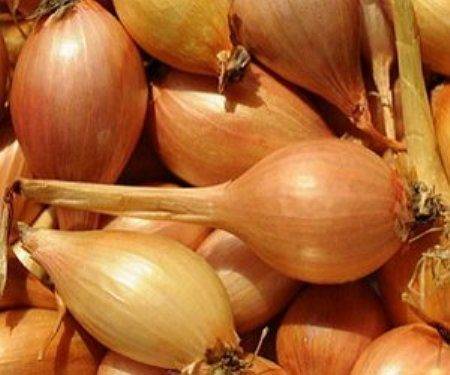

One of the best varieties of the "family" - fruitful, unpretentious in cultivation, perfectly preserved throughout the winter. In one nest, usually up to 8-10 onions are formed, the average weight is 50-60 grams. The upper scales are reddish in color, the pulp is juicy, with a pink tint.
Velikoustyugsky
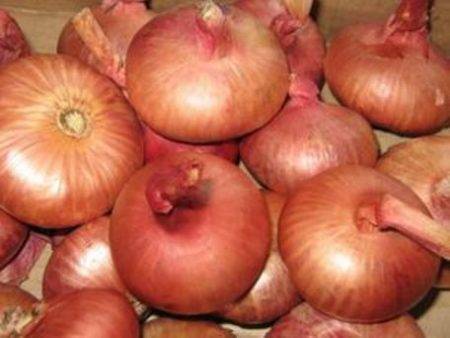

This family onion has long been grown in the Russian North. The bulbs are burgundy in color, have a dense pulp. Average weight is up to 70-80 grams. The peculiarity of the variety is a vigorous and pungent taste. Up to 8-10 bulbs grow in one nest.
Old Believer
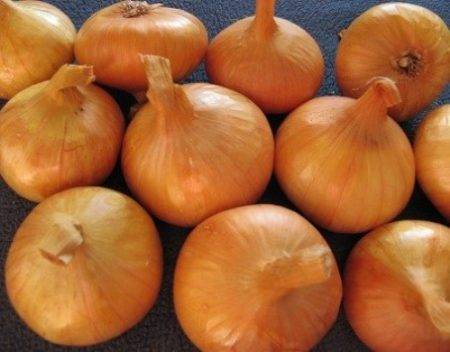

There are real legends about this onion, as it is believed that its bulbs have valuable medicinal properties. The variety was bred in the Old Believer sketes of the North, very unpretentious, with large bulbs. The covering scales are coppery, the flesh is white.
White Queen
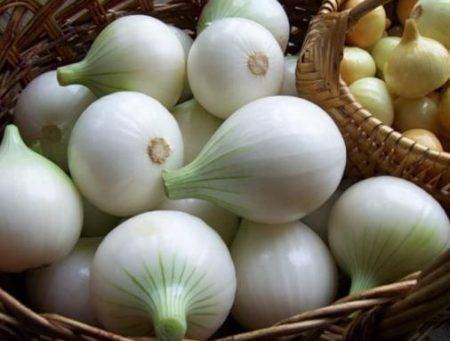

An unusual variety of family onions, differing in color - the upper scales are creamy. The pulp is white, has a pungent spicy taste. One plant forms up to 7-10 bulbs, each weighing up to 60-70 grams. The shape of the bulbs resembles a large chicken egg.
Grandee
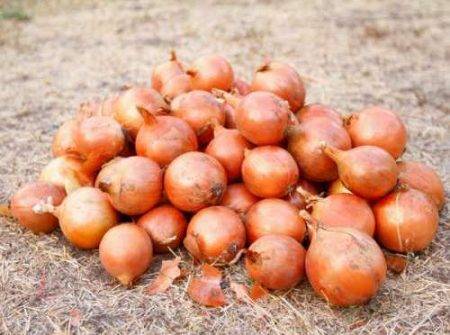

A family variety that is suitable for both greens and bulbs. In the nest, up to 6-11 onions grow, which have an original flat shape. The onions are yellow.
Prometheus
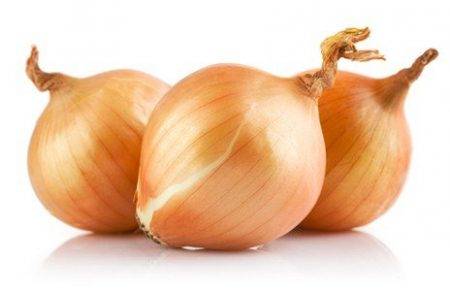

The Prometheus family onion is distinguished by its mild taste and high yield. This variety is large enough - up to 80 grams, in one nest, with proper care, it grows up to 8-10 full-fledged mature bulbs.
Water lily
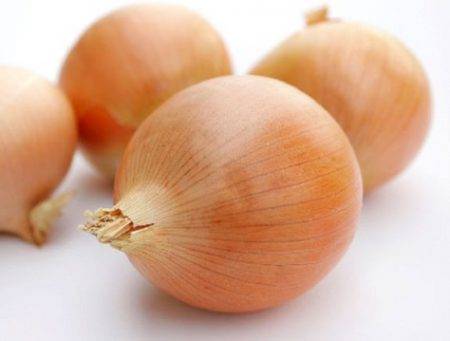

Those who love sweet onions should pay attention to the Water Lily variety. Its bulbs, shaped like small beautiful jugs, have a juicy flesh without bitterness. One plant forms up to 5-6 bulbs, each weighing up to 70 grams.
Almost all of the listed family onions are early-maturing varieties that are suitable for growing in the middle lane, regions of the North-West, the Urals and Siberia. Ripening time - on average 80-90 days from the moment the first sprouts appear in the open field. There are no special rules of agricultural technology for each of these regions, usually gardeners are guided by the climatic conditions of the area. So, in the suburbs and the middle lane it is warming faster than in Siberia, and therefore the timing of the landing of the "family" will be earlier.
Such onions are harvested from late July to mid-August and again, they are guided by the weather and climate of the region.
What is the difference from onion?
- Unlike onions, family onions do not cause tearing from the eyes when cleaning, and after eating it, there is no need to fear bad breath.
- Shallot bulbs are smaller and more elongated, growing in nests.
- Family onions contain more ascorbic acid, B vitamins and carotene. And its leaves are ahead of the greens of ordinary onions in terms of the content of manganese, potassium, copper and phosphorus.
What is the difference and similarity between shallots and onions can be found here.
With proper agricultural technology, family onions are capable of producing a yield by weight no less than small-germinated onions. And its undemandingness to growing conditions is just a godsend for vegetable growers with problem soil.
Growing features and planting dates
Agrotechnics of family onions is not difficult. All basic techniques are standard, the main thing is care and regular care.
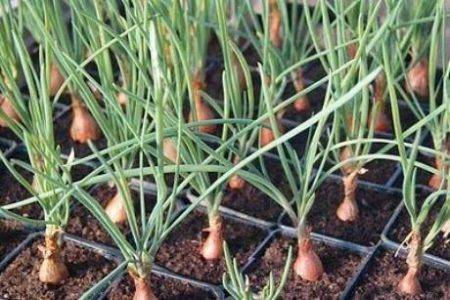

Since this variety is a fairly cold-resistant plant, it is necessary to choose the optimal planting time correctly. Some gardeners plant a "family", waiting for warm spring days, and make a mistake in doing so. With such a planting, the onions begin to "drive" the feather intensively, and the roots will be insufficiently developed. This will negatively affect future bulb weight and overall yield.
Therefore, the best time for planting falls on the period when the temperature was set within + 2 ... + 14 ° C, and the soil warmed up to about + 5..6 ° C.
In most regions of Russia, this temperature regime occurs in mid or late April. Much, of course, depends on the specific season, so you need to focus on the weather.
How to cut before planting
The planting material needs to be prepared, while, along with the traditional disinfection, soaking in nutrient solutions and germination, it is customary for the “family” to cut the onions. This makes it possible to get not only a high yield, but also larger bulbs.
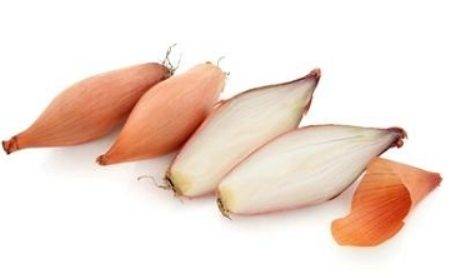

It is most often cut in half, vertically, but it can also be divided into four parts. In this case, you need to know the following: the rudiments, like the roots in the lower part, are unevenly located in the bulb, therefore, when cutting, it is necessary to make sure that in each lobe there are both rudiments and roots.
Trimming the top (near the neck) is not recommended, as this usually gives a good increase in greenery, but it also reduces the weight of the onions themselves.
For disinfection, the "family" is soaked in a solution of potassium permanganate (the solution should be pink) or in a solution of copper sulfate (one tablespoon of vitriol is taken in a bucket of water).
It is also advisable to soak the onions for about 10 hours in any growth stimulant. A compound fertilizer can be used to allow the onions to replenish the nutrients they need for growth. After that, the onions are germinated for several days in a container, filled with water so that the roots appear. And only after that, just before the planting itself, they are cut and planted on the ridge.


Soil preparation
The family onion loves light nutritious soils, but grows well on loam. It is advisable to prepare the garden in the fall, at the same time fertilizers are applied. You can use humus, compost, adding superphosphate (about 25 grams) and potassium salt (15 grams). All application rates are per square meter.
The location should be sunny, without winds. The best garden crops to grow before onions are:
- carrot;
- potatoes;
- legumes.
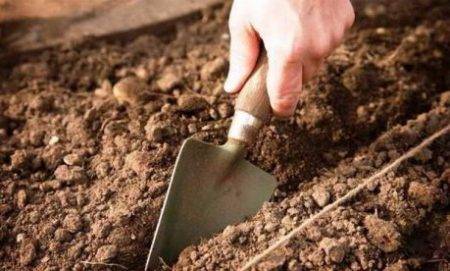

It is unacceptable that groundwater passes near the place where the onions are grown; it is also undesirable for snow to accumulate here and there is a lowland.
Can I plant before winter?
Many gardeners successfully plant "family" bulbs before winter. In this case, earlier harvests are obtained, and the greens can be cut already at the end of May - beginning of June.
It should be remembered that the planting of onions before winter is carried out at such times that the onions can take root, but at the same time do not grow. Usually - this happens in late September - early October.
Features of planting in spring
If the bed was prepared in the fall, then in the spring you only need to thoroughly loosen the soil, then make grooves for planting the onions.
The furrows themselves are carefully shed, then wood ash can be added. Many gardeners simply sprinkle ash on the furrows, others lightly embed the fertilizer into the soil.
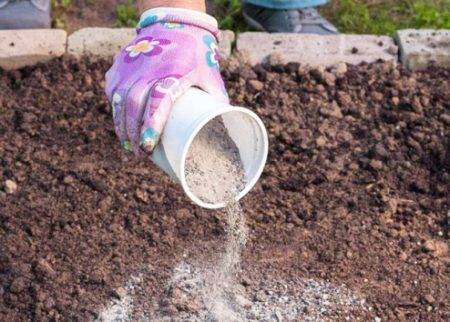

Landing scheme
The family onion loves space, therefore, when cutting rows, it is important to observe certain distances:
- between rows - up to 20-25 cm;
- between the onions - up to 10 cm.
For planting, medium-sized onions should be selected (if planting is in whole specimens), as well as cut slices of a large "family".
A trifle can be planted only to obtain greens, and a thickened planting is also suitable for such bulbs.
Crop care
So, the onion has been planted and now, for about 8-10 days, you can only observe the onion bed. You should not rush to water the onions, let the roots of the plants themselves "find" moisture in the soil. This approach contributes to the growth of a strong root system, which means - and the formation of high-quality full-fledged bulbs in the future.
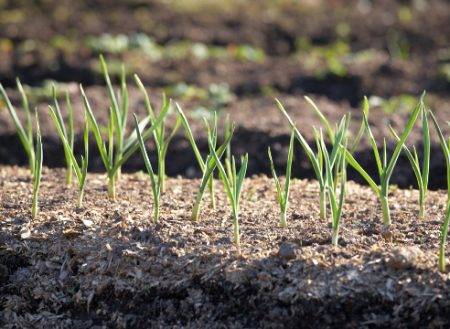

Once the greens of the onions reach 8-10 centimeters, the plants can be mulched. It is best to use cut grass or hay for this. What is mulch good for? It retains moisture in the soil, provides air access, and provides reliable protection against weeds.
Top dressing
Many are interested in whether it is necessary to feed the onion? If fertilizers were applied in the fall according to the norms, then such a "dinner" for a family onion should be enough for the entire season. But it may also be that the onion grows slowly, its feather is too small and weak. This means that you need to make top dressing:
- take 10 grams of ammonium nitrate and 15 grams of potassium salt in a bucket of water;
- from organic matter, mullein or bird droppings are used, diluted with water in a ratio of 1:10 and 1:20.
Also, a good effect is given by watering the onion with an infusion of wood ash.
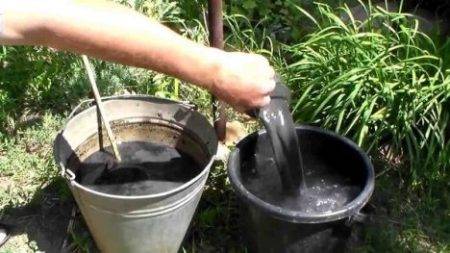

Watering
The irrigation regime depends on the weather, the amount of precipitation, and the characteristics of the soil. The general rule is this: family onions are watered about once a week, the calculation is 20 liters per "square" of the garden.
Both waterlogging and strong drying out of the soil are not allowed. Therefore, a good "helper" will be mulch, which provides the onion with optimal conditions for growth. Watering is needed in the first growing season of plants, then they are stopped.
How to grow large family onions
Many gardeners refuse to grow a "family", believing that they cannot get large and full-fledged bulbs with it. But in reality this is not so, and with proper care, as well as the selection of high-quality seed, the results will be very good. 7. Some "secrets" from experienced gardeners, who have been receiving large onions for many years, will also help.
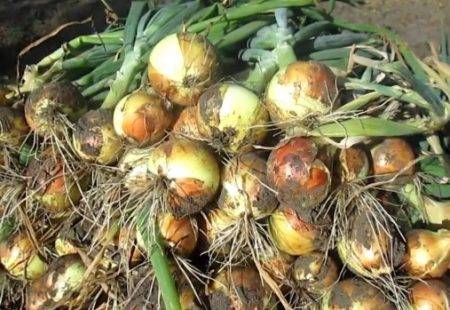

- After harvesting and before planting, onions need to be sorted. Often inexperienced gardeners select small family onions for planting. But this leads to a crushing of the variety and a significant decrease in the overall yield.
- Medium bulbs are taken for food, large ones for planting for the next season, small ones are usually planted for greenery.
- Large specimens are cut before planting, as a result, a small number of good full-fledged bulbs will grow in the nest.
- Another technique: during the formation of the nest, one or two smaller onions are removed from it, leaving 3-4 pieces there.
- In order for the bulbs to grow large, you cannot cut the feathers from these plants for greens.
Also important is the correct selection of the place for the onion, good soil, since large bulbs cannot be obtained on heavy and poor soils.
Your personal gardening consultant!
Family bow, who does not know him. But if you look, almost no one. Everyone knows Kushchevka, but the name "family" is somehow rare. But both the first and the second are different names for the same type of onion.
Why family?
Maybe because in one nest a friendly "family" of full-fledged bulbs grows from one small onion. On average, this is from 3 to 10 pieces, under very favorable conditions, and all 20. Maybe because in the spring the family onion gives the very first greens in an amount sufficient for the whole family. True, in order to get this greens in early spring, planting of planting material must be carried out in the fall. And here, many gardeners have a natural question about when to plant family onions before winter and how to do it correctly. But everything is quite simple if you follow the order of work.
In principle, you can plant family onions for the winter without preparing the soil. But not everything is so simple, since nothing can be done with the soil only in the cultivated garden. The earth has already been dug up, has sufficient looseness, maybe even fertilizers were applied. Virgin soil is another matter. She doesn’t need to dig it. Maybe they wouldn't dig the virgin soil, only you can't stick an onion into the turf. Therefore, if someone is not sure whether it is possible to plant a family onion before winter in an unprepared area, then it is better not to suffer, but to dig up the soil. It will not hurt the garden, and you are calmer yourself.
After bringing the soil into proper condition, it should be: - at least a little loose; - moderately moist; - neutral in acidity (desirable).
The site itself should be well lit and warm. Next comes the introduction of organic matter and minerals, after which the planting itself. Also, if the garden is being dug up, this must be done in advance. After loosening, the soil must settle and compact.
How to fertilize the earth
To say that family onions cannot do without fertilizers at all would be untrue. Even on sandy soil without top dressing, it grows quite well and gives a sufficient amount of greenery. But you always want to have more harvest, that's just how to achieve it. The amount of onions increases due to the applied fertilizers. There are 3 options for fertilizing the beds. First, minerals are added. The second is organic matter. Third - the first is combined with the second.
If it is decided to plant a family onion just before winter, it is recommended to add for each square meter: - 25 grams of superphosphate; - potassium salt 15 grams; - ammonium nitrate 5 grams.
It's easier with organics, it is always at hand. Before planting onions, the soil is fertilized with humus, preferably 3 years old. Or rotted compost. For 1 m², about 5 kilograms of one or the other is applied. Plus some ash, so that the ground turns a little grayish. Particular attention should be paid to fertilization in the form of humus. It should be just humus, not fresh manure. The manure forms loose, unsuitable for food bulbs and massive "tops".
Some zealous gardeners advise combining minerals with organic matter. Probably, after such a procedure, the harvest will be large. But again, you can plant family onions for the winter even in the soil without fertilizers at all. And if you need a large crop, you can get by with humus or compost. But this is an option. In the garden, only the owner decides what to bring.
Read also: Cucumber Director F1: reviews, description of the variety, photos, characteristics
When and how to plant family onions before winter
First, in terms of timing. Sometimes gardeners are interested in when to plant family onions before winter so as not to lose money. If we talk about days, then in the middle lane the best time is the tenths of October. It's approximately. But if anyone knows the climate of their area well, then a month before the first frost. The planting process itself consists of two stages. The first is the choice of planting material. The second is the choice of the landing pattern and the landing itself.
At the first stage, you should decide what you would like to get in the next season - greens or marketable bulbs. If greens, take onions up to 1.5 centimeters in size. If the bulbs are full, then the seed size should be about 3 centimeters. In the first case, the bulbs are deepened by 2-3, in the second by 5-6 centimeters. Some gardeners practice planting large onions cut into 2 halves.
How juicy the greens will be in the spring and how complete the “new” bulbs will be depends also on the chosen planting scheme. Planting greens in a row are placed after 10 centimeters, on commercial bulbs after 15. The distance between rows can be from 20 to 30 centimeters.
For the main work, that's all. Now the question of whether it is possible to plant a family onion before winter is probably not so acute. For those who want to have fresh greens right after winter, planting onions in the fall is not only possible, but also necessary. By the way, if, before winter, individual plantings are arranged according to the scheme on greens, and in the spring, part of the young growth is collected for food, the remaining plantings will produce a good harvest of healthy, full-fledged bulbs.
Share useful information:
Harvesting family onions
In most Russian regions, the feather of the family bow begins to fall as early as the end of July. This is the main signal that harvest time is coming.
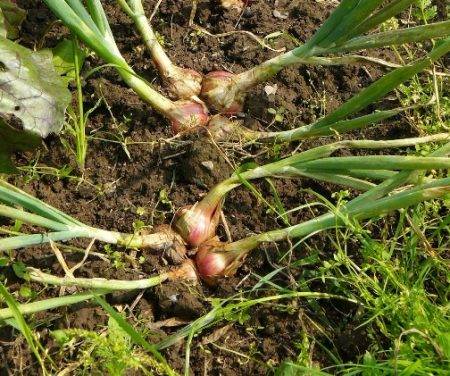

If you delay harvesting, the bulbs will begin to reactivate in growth, thereby disrupting their dormant period.Such a bow will be poorly stored.
A sunny, clear day is chosen for harvesting. The onions are carefully dug out of the ground, shaken off the soil from the bulbs, and laid on the garden bed to dry. If the weather does not allow drying the onions on the ridge, then you will have to remove them under a canopy and dry them there.
The time it takes to dry the onions is approximately 15 days. They are dried in attics, on the veranda, under awnings closed from the rain, laying out the bulbs in one layer and turning them over regularly.
The temperature should be in the range of + 20-30 ° C. All damaged specimens are removed to prevent rotting of other onions.
With well-dried onions, the neck becomes thin and completely dry. In addition, the bulbs emit a pleasant rustle when sorted. Once you are sure that your onion is dry, you can carefully trim the feather, leaving no more than 3-4 cm.
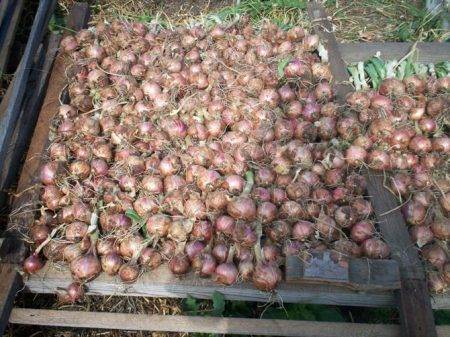

The work of forming the onion nest
Family onions are multi-nested, so gardeners begin to mark the number of bulbs for themselves in the middle of summer. At this time, the separation of onions begins, and therefore you can begin to form nests. This will allow you to grow large family onions.
On average, up to 5 bulbs should "sit" in the nest, in which case they will really grow large. What if there are not five “tenants” in the nest, but ten or fifteen? It is necessary to remove unnecessary copies, carefully pulling them out so as not to hurt the rest. The largest four to five bulbs are left in the nest, the small ones are used for harvesting, for food.
How to store
The family onion is perfectly stored at home, subject to the temperature regime. The optimum temperature is + 18… + 22 ºС, the humidity is low.
Many people store onions right in the kitchen, scattering them in baskets, boxes, boxes. "Family" is unpretentious, well stored, but in winter you should still occasionally inspect onions, rejecting dried or soft specimens.
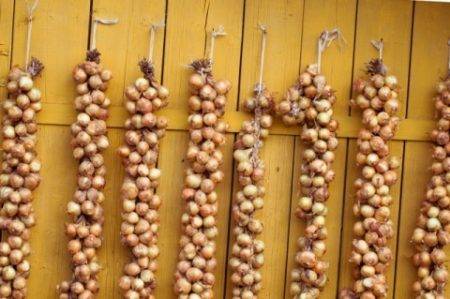

About pests, problems and diseases of family onions
Reviews of many experienced gardeners indicate that this type of onion is resistant to many "traditional" diseases, as well as to pest damage. Prevention and adherence to the rules of agricultural technology is the guarantee that onion plantings will not be threatened by any misfortunes.
- It is required to plant family onions as early as possible.
- For planting, it is required to select only high-quality and healthy seed material.
- The bulbs must be soaked in special solutions for disinfection.
- It is necessary to follow the landing patterns, distances.
- To protect against onion flies and other pests, it is advisable to use such measures as:
- dusting plantings with wood ash, tobacco dust, a mixture of black pepper and ash;
- planting onions next to carrot beds;
- regularly loosen the soil in the aisles;
- lay out wormwood, wild rosemary, tomato tops between the rows of onions, which scare away pests with their pungent smell.
The treatment of plants with Bordeaux liquid (1%) also helps. Usually one or two procedures are enough for prophylaxis.


It is advisable to avoid the use of chemicals on the site, using them only in the most extreme cases.
Why does the onion feather turn yellow
The causes of yellowing can be very different, respectively, and the solution to the problem will be different.
- Plants may be deficient in nitrogen. In this case, the tips of the leaves whiten slightly, and the surface of the feather acquires a yellowish tint. Solution: use organic fertilizing.
- Feathers can turn yellow with a lack of potassium. In this case, the tips may even curl slightly. Solution: apply top dressing with ash or potassium salt.
- Yellowing is caused by a pest - an onion fly, the larvae of which damage the bulb and feathers. Solution: dusting of plants and beds with ash, mixtures of tobacco, pepper, application of Fitoverm or Agravertin preparations.
- Severe waterlogging of the soil also causes yellowing of the feather.You should regularly loosen the beds, make small grooves so that the moisture goes away (this usually happens in a rainy summer).
- If the feather begins to lay down and turn yellow at the end of July, this means that it is time to harvest the onions.
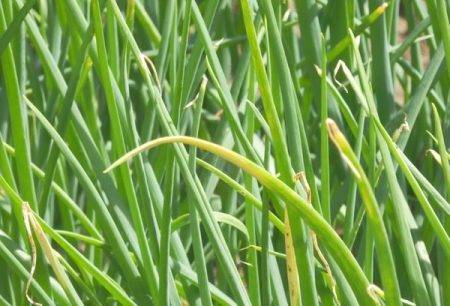

The bow went to the arrow
The family bow goes to the arrow only if the storage conditions have been violated. The only correct solution is to comply with the temperature regime in winter and a low level of humidity. The peduncles of the plants are neatly broken out.
The bow is not tied
It happens that the onion "leaves" in the feather, building up a powerful green mass, but at the same time the bulb is tied poorly. This may be due to violations of the timing of planting crops (planted late and in warm weather), improper care, an excess of nitrogen in the soil.
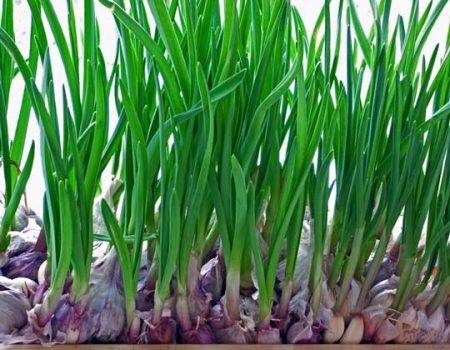

To avoid this, you must:
- planting family onions as early as possible;
- do not water the plants in the first 7-10 days after planting in order to build up a good root system;
- do not overfeed with nitrogen, otherwise only feathers will grow in the "family";
- about two or three weeks before harvesting, it is required to shake off the soil from the bulbs, slightly exposing them for better ripening;
- choose healthy and high-quality planting material for growing.
Family onion is an unpretentious and fruitful crop that has long been grown in many Russian regions. Subject to very simple recommendations, even inexperienced gardeners will be able to grow good yields and get full-fledged bulbs of this wonderful vegetable.
Planting family onions in the ground
To accurately determine when it is time to plant family onions, you need to observe the weather. The best time to plant is mid-April, but if you do it too early and the weather is cold for a long time in spring, the bow may start shooting. Therefore, the exact time of planting depends on the weather conditions in a particular region. In the south, family onions can also be planted in early April.
The root system of onions develops well at temperatures from 2 to 25 ° С and tolerates frosts down to –6 ° С. Leaves grow actively at temperatures of 15-25 ° C, withstand frosts down to –7 ° C and withstand heat at 35 ° C. Therefore, the family onion feels good in the unstable climate of the middle lane.
Family onions can be planted before winter, but you need to choose the right varieties, otherwise the plant will shoot. For podzimny planting recommended varieties Albik, Garant, Krepysh, Ryzhik, Seryozha, Siberian yellow, SIR-7, Sophokl.
Shallots are an unpretentious plant that develops normally on any soil with neutral acidity, but moist humus-sandy or light humus loams are considered the best soils for it. The best predecessors for this crop are carrots, potatoes and legumes.
The main difference in the technique of planting family onions from ordinary onions is the distance between the bulbs. Shallots should not be planted very densely as each bulb forms a bulky tuft of leaves. If the plants overlap, the leaves lack light and nutrition. As a result, the bulbs grow very small.
It is recommended to grow shallots in rows, the distance between which is 30-40 cm. The distance between the bulbs in a row depends on the size of the planting material. Large family onions are planted at a distance of 20-30 cm, medium - after 15 cm, and small - after 8-10 cm.
Planting depth - 2-3 cm. If the bulbs are placed closer to the surface of the ground, the roots will suffer from a lack of moisture and nutrients.
Before planting, it is recommended to pickle the bulbs in a pink solution of potassium permanganate or in a solution of copper sulfate (1 tablespoon per 10 liters of water) for 20 minutes.
Features of agricultural technology
The family onion loves loose, humus-rich, neutral soil and a sunny location. Excellent predecessors are peas, beans, potatoes, carrots. It is recommended to add 3-4 kilograms of rotted manure and a glass of ash per square meter in the spring.
Family onions must be planted at a much greater distance from each other than regular onions. This is due to the fact that shallot nests grow strongly and, planted at a close distance, will become shallower due to lack of nutrition and light. In a row, the bulbs are planted at a distance of 20-25 cm from each other to a depth of at least 3 cm.The row spacing is formed at 35-40 cm.
On a note! Before planting, the bulbs are kept for 10 minutes in a pink solution of potassium permanganate, then for 10 minutes in a solution of sodium chloride: 1 tablespoon per liter of water. The treatment is completed by dusting wet onions with wood ash.
The aisles are mulched to prevent weeds from germinating. Watering is carried out as the soil dries up, it should always be moist.
Harvest the shallots when about half of the tops are covered. Dry in the shade until the leaves are completely dry, which are then manually removed. If you follow agricultural techniques, then the family onion is not affected by diseases and is perfectly stored.
Be sure to place ancient and delicious varieties of shallots of national selection on your site. They have been tested by time and the experience of many generations of gardeners.
Adding an article to a new collection
This type of onion is prized by gardeners for its juiciness, aroma and mild taste. At the same time, the bulbs are stored for a long time and do not get sick. We will tell you how to grow family onions on your site.
A family (or just a family) is called a multi-pronged onion. The most popular type of such plant is shallots. It is a type of onion, but with smaller bulbs (4 to 10), growing nests, and delicate leaves. The weight of the nest is 150-300 g.
The small size of the shallots is inconvenient to peel, but they make excellent dishes. Family onions are fried, stewed, pickled and even used to make jam. And when fresh, sweet and delicate shallots are the perfect salad ingredient.
In addition, the heads can be stored well (from 8 to 12 months), even at home. And in March, the bulbs can be planted in a container and placed on the windowsill. Then in the spring you will enjoy fresh herbs without leaving your home.
Family onion care
In order for the plant to develop correctly, the air humidity must be in the range of 60-70%, and the soil must be much higher. As a rule, the plants are watered once a week, but during the onion growth the soil should be constantly slightly damp.
To preserve moisture, it is better to mulch the soil with straw or mowed weeds with a layer of 5-10 cm. In early July, the mulch is removed. If the soil is not mulched, shallots need regular weeding and loosening of the soil.
When growing onions in fertile soil, additional fertilizing can be omitted. If the soil is poor, before planting the bulbs, add rotted compost (3-4 kg per 1 square meter), as well as 1 tsp each. urea and superphosphate and 2 tbsp. ash.
Planting before winter with seeds
- It is better to plant onions in a sunny place, in the soil without moisture stagnation;
- Seeds are sown in August or September. By the onset of frost, a rosette of leaves appears, which will winter;
- Before planting, the seeds are soaked for 3 days, while the water is changed 3 times a day;
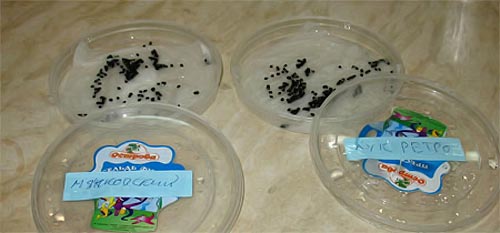

- The soil must be moist. Loamy and black soil are best suited, acidic soil is the worst, it must be limed before planting. It is preferable that the previous crops were cabbage, legumes, tomatoes, potatoes and cucumbers;
- Before planting, the ground is watered;
- Introduce 1 m 2 half a bucket of humus, 1 tablespoon of potassium sulfate and double superphosphate, a glass of ash;
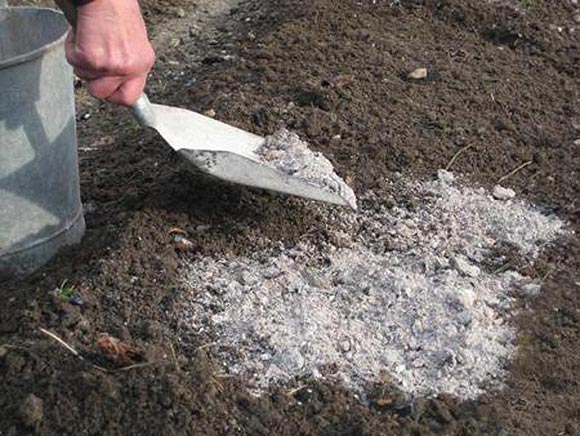

- The seeds are buried 1-1.5 cm into the grooves, the distance between which should be 20 cm. The distance between the seeds in a row is 10 cm;
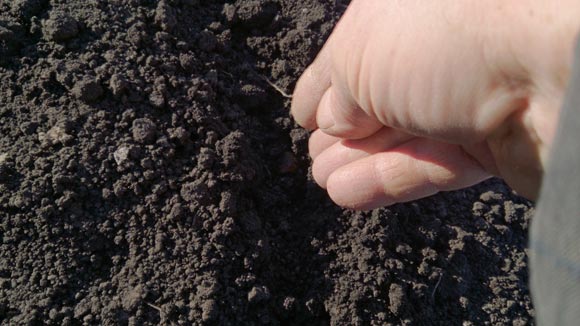

- Seal;
- Mulch the bed with peat, straw, compost, etc. when it gets cold;
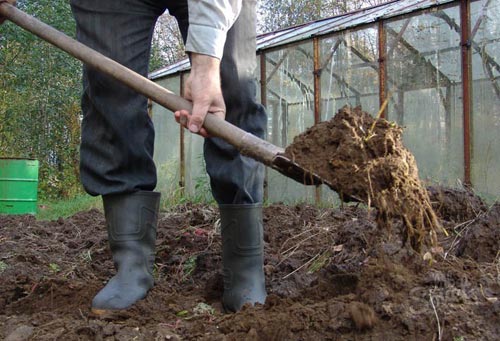

- When the snow falls, it needs to be thrown over the mulch on top for greater insulation.
When and how to remove family onions from the garden
If you plant a family onion in the spring or before winter, then in July it can be removed from the garden. This is done when 50-70% of the leaves of the plant are covered. But do not delay harvesting family onions, otherwise the bulbs will be worse stored.
In sunny and dry weather in the morning, when the dew dries up, the onions are pulled out and left in the garden until the evening. Then they are cleaned and dried in the attic or under the roof for 10-12 days. When the leaves are dry, they are removed by hand and the bulbs are stored in wooden crates or cardboard boxes. In this case, the nests are not divided into separate bulbs.

